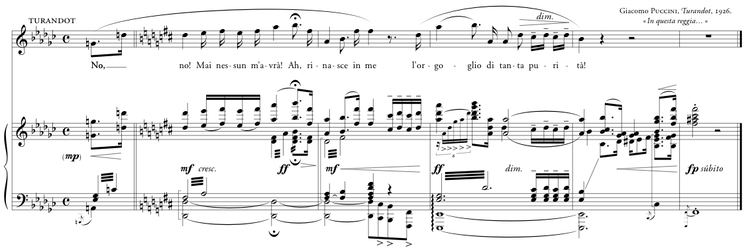 | ||
"In questa reggia" ("In this palace") is an aria from Giacomo Puccini's opera Turandot set to a libretto in Italian by Giuseppe Adami and Renato Simoni. The text is based on Friedrich Schiller's adaptation of the play Turandot by Carlo Gozzi. The aria takes place in Scene Two of the Second Act, and is sung mostly by the Princess Turandot (soprano), but with a reply from Calaf (tenor), which is a key point of the opera.
Contents
The riddles challenge
In the aria, Turandot explains that she conceived the three riddles as a test for any prince who might want to marry her. She explains that in the same palace, countless generations ago (thousands of years ago), a reigning Princess Lo-u-Ling was conquered by the King of the Tartars, raped and murdered. In particular, she dwells upon the Princess' final crying out and her moment of death at the hands of a man. Based on the memory and the concept of that crying out having been carried down through the many generations to Turandot herself, she resolves to avenge that death by imposing it on all men who fail in the attempt to marry her. She warns the prince that if he fails to answer any one of the three riddles, he will die.
The climax of the aria occurs with the word "grido" ("outcry" or "crying out") and clearly Turandot is reliving and personifying the last moments of her ancestor, its outrage and its long awaited vengeance.
The orchestra emphasises her ominous final couplet:
Straniero! Non tentar la fortuna!Gli enigmi sono tre, la morte una!Stranger! Do not tempt Fortune!The riddles are three, Death is one!But Calaf returns this to her as
No,no... gli enigmi sono tre, una è la vita!No, no... the riddles are three, Life is one!Some of the very distinctive music which ends this aria, reappears briefly in the Act 3 duet Principessa di morte (as completed by Alfano), as Calaf finally embraces a still-reluctant Turandot.
Historic Recordings
Historic recordings go back nearly to the first performance, with those by Eva Turner being particularly notable and available on the web. Turner was present at the first performance, and performed the opera 7 months later and throughout the pre-war years.
